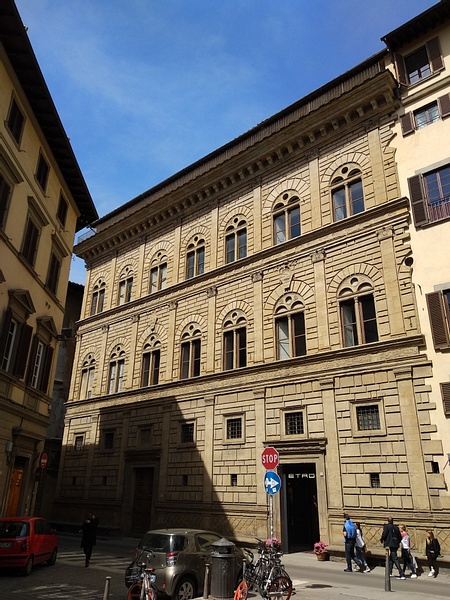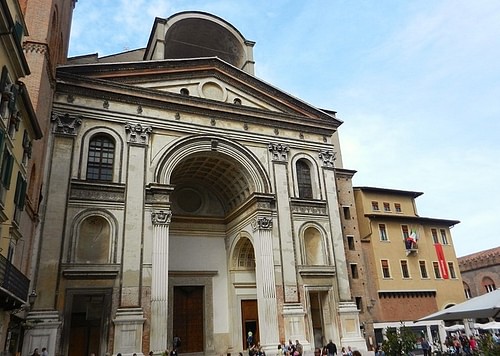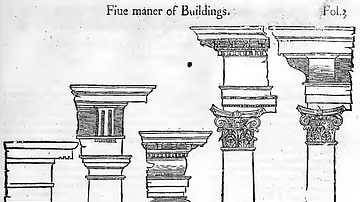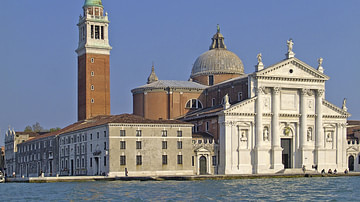
Leon Battista Alberti (1404-1472 CE) was an Italian scholar, architect, mathematician, and advocate of Renaissance humanism. Alberti famously wrote the treatise On Architecture where he outlines the key elements of classical architecture and how these might be reused in contemporary buildings. Even more influential were his writings on painting and sculpture, which transformed the theoretical practices of Renaissance artists. Alberti put his ideas into practice and designed many churches in various Italian cities, perhaps the most influential being the San Andrea of Mantua (1470 CE), the first monumental classicizing building of the Renaissance.
Early Life
Alberti was born in Genoa on 14 February 1404 CE. He was an illegitimate member of a wealthy merchant-banker family, which had been exiled from Florence in 1387 CE. The family moved from Genoa to Venice and, thanks to his father Lorenzo, Alberti enjoyed a school and university education in Padua followed by a stint at the University of Bologna. Alberti's education included mathematics, Greek, Latin, classical literature, and, finally, a doctorate in canon law from Bologna in 1428 CE.
Alberti moved to Rome where he worked as a papal secretary from 1432 CE. One task at the Papal Chancery was to write a new version of the lives of the saints and martyrs. The young scholar took holy orders and this brought with it several benefices that improved his income significantly. However, his position in the church seems not to have had any influence at all on his humanist writings or his treatises on art and architecture. When the Medici family took power in the early 1430s CE, Alberti was finally able to return to his ancestral home. Florence was then the capital of Renaissance art and architecture where men like Donatello (c. 1386-1466 CE) and Filippo Brunelleschi (1377-1446 CE) were reviving the ideals of classical antiquity. Alberti would later write that his contacts in Florence inspired him to participate in this revival himself.
Alberti continued in his role as a papal secretary but also acted as a sort of artistic consultant to rulers in various Italian cities such as Florence, Ferrara, Mantua, Urbino, and Rimini. Moving around Italy gave Alberti a great insight into the many Greco-Roman remains still visible and perhaps inspired him to make plans for a survey of ancient Roman buildings in Rome. Alberti's study of ancient architecture resulted in him noting that there were actually five and not four classical orders as previously thought. This fifth one, subsequently called the Composite order, was a mix of elements from the Ionic and Corinthian orders. Also interested in architectural theory, Alberti was a keen student of On Architecture by the Roman architect Vitruvius (c. 90 - c. 20 BCE). Accordingly, when Alberti moved into this new field in more practical terms, he wanted his buildings to both imitate the austere grandeur of ancient Greece and Rome's finest buildings and reproduce their classical ratios of height and length. Another important consideration was that buildings should display a harmonious balance between function and decoration.
Architectural Projects
Alberti, a quintessential Renaissance man, was keen to put his ideas into practice. In 1447 CE he had already become the architectural adviser of Pope Nicholas V (r. 1447-1455 CE). Alberti designed the new facade for the Santa Maria Novella church in Florence around 1458 CE, although construction was not completed until 1470 CE. Less obviously classical than his other works, this is due to limitations set by the structure of the church itself - a Gothic church has a high central nave and lower sides making it difficult to face with a symmetrical classical structure. Alberti's solution was to create a facade with three equal-sized squares: one on either side of the door and another on the upper storey, which is topped by a triangular pediment. Other classical elements include the Corinthian capitals and the upper part of the facade strongly resembles a Roman temple front.

In Mantua, Alberti designed two churches of note, San Sebastiano in 1460 CE and the Basilica of San Andrea c. 1470 CE (construction began in 1472 CE). Both display elements of classical influence. The San Sebastiano church was planned according to a Greek cross while the San Andrea Basilica has a facade which directly imitates elements of an Etruscan temple as described by Vitruvius. This specific intention is referenced in a letter written by Alberti to his patron Ludovico Gonzaga (1412-1478 CE). The San Andrea facade has a massive arched doorway, and this is curiously reminiscent of a Roman triumphal arch, a theme that is repeated in the church's interior piers, nave arcades, and massive barrelled ceiling which is just over 17 metres (56 ft) across, making it the largest constructed since antiquity.
The architect's new facade for the Tempio Malatestiano in Rimini (aka the Church of San Francesco), actually his first architectural project of note, is an even more overt reference to the triumphal arch. Indeed, the marble facade was originally intended to be topped by a central arch of its own but was never completed. Elements of the facade were even directly copied from the nearby Arch of Augustus. All of these developments in use of classical themes for Christian buildings were almost too bold, and few architects were willing to follow suit. For the next few decades, secular buildings would continue the trend, and only later would church architecture join once again the humanist wave of change that saw classical architecture being reused and reimagined.

Alberti was himself involved in secular architecture, notably the c. 1450 CE Palazzo Rucellai in Florence with its flattened facade of pilaster columns and perfect symmetry. The ground floor has pilasters with Doric capitals, the upper two floors have Corinthian capitals. Another nod to Roman architecture is the carved diamond decoration on the lowest floor, which reminds of opus reticulatum, that is walls constructed using square- or pyramid-shaped blocks of tuff set in a diagonal grid pattern. This was the first Renaissance building to receive a facade using the classical orders.
Treatises
Alberti wrote his own treatise on architecture, On Building (De Re Aedificatoria) in 1452 CE (the Latin version), which was translated into the Tuscan vernacular in 1456 CE. He would continue adding and revising the work for the next 20 years. Alberti catalogued what he considered the defining principles of classical architecture and noted how these might be applied to contemporary Renaissance buildings. He emphasised the need for buildings to be visible from all sides, that the designer should equally consider the interior and exterior, and they should be impressive both in size and appearance. The book was hugely influential - the historian J. Kelly-Gadol notes that it became 'a bible of Renaissance architecture' - and it gained even more readers when it was finally published as a ten-volume printed set in 1485 CE (hence its other title in English, Ten Books on Architecture). As a result of this work, Alberti became known as the 'Florentine Vitruvius'.
Alberti wrote a treatise on painting, De pictura (On Painting), in 1435 CE (in Latin, and vernacular the next year, Della Pittura), and another treatise on sculpture around 1464 CE. Both of these works look at the various techniques and theoretical principles artists should employ. Alberti recommends that painters study nature, provide variety in their work, and try to convey emotion in their figures. He states, too, that the single vanishing point that gives a painting perspective should be at the eye-level of the viewer. These treatises helped in the process that saw Renaissance artists rise above their common status as craftworkers and emphasised that they were also involved in intellectual endeavours such as studying the history of art and learning theories of mathematical perspective, geometry, and proportion. Not only did painters take note of these treatises but also patrons and so Alberti is credited with being a prime instigator of Renaissance humanism as expressed in the arts and architecture.

Alberti wrote on many other subjects such as religion, grammar, mathematics, cryptography, geography, and map-making. Beginning with his 1432 CE treatise Della famiglia (On the Family), he wrote many dialogues covering moral philosophy, especially in relation to his beliefs on Renaissance humanism. Alberti once wrote, "Man is a mortal but happy god because he combines capacity for virtuous action with rational understanding" (Rice, 89). One of the author's final works was De iciarchia (On the Man of Excellence and Ruler of His Family), which presents Alberti in a dialogue on humanism and the success of blending theory and practice in the arts, which was now going on in Florence and beyond. De iciarchia was written in the Tuscan vernacular and combined with his book on the grammar of that language; Alberti made a significant contribution to the standardisation and adoption of it in prose works.
Death & Legacy
Alberti died in Rome on 25 April 1472 CE. His treatises on the arts continued to be popular after his death and were used as guides by many wealthy Renaissance patrons, including Lorenzo de'Medici (1449-1492 CE), ruler of Florence, and Ercole d'Este (1431-1505 CE), Duke of Ferrara. His treatise on architecture was translated into multiple European languages and remained popular into the 18th century CE. Besides the content of relevance to practising architects, the work began a wider discussion on the role of architecture in society, the relation of a building's design to its function, and got people talking about architecture who were not directly involved in that field. Alberti's buildings, and especially his classical-inspired church facades covering older Gothic structures would influence later great Renaissance architects such as Donato Bramante (c. 1444-1514 CE), Sebastiano Serlio (c. 1475-1554 CE), and Andrea Palladio (1508-1580 CE), creating a line of evolution in buildings that culminated in the triumph of St. Peter's Basilica in Rome.











